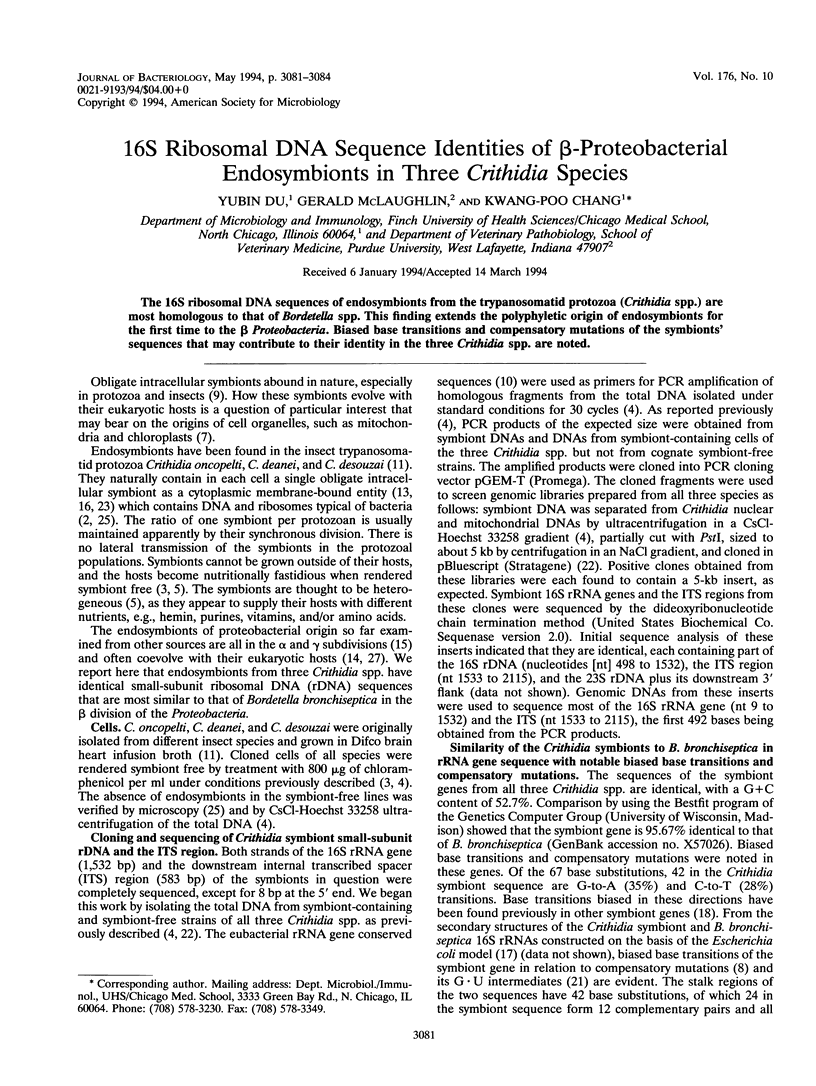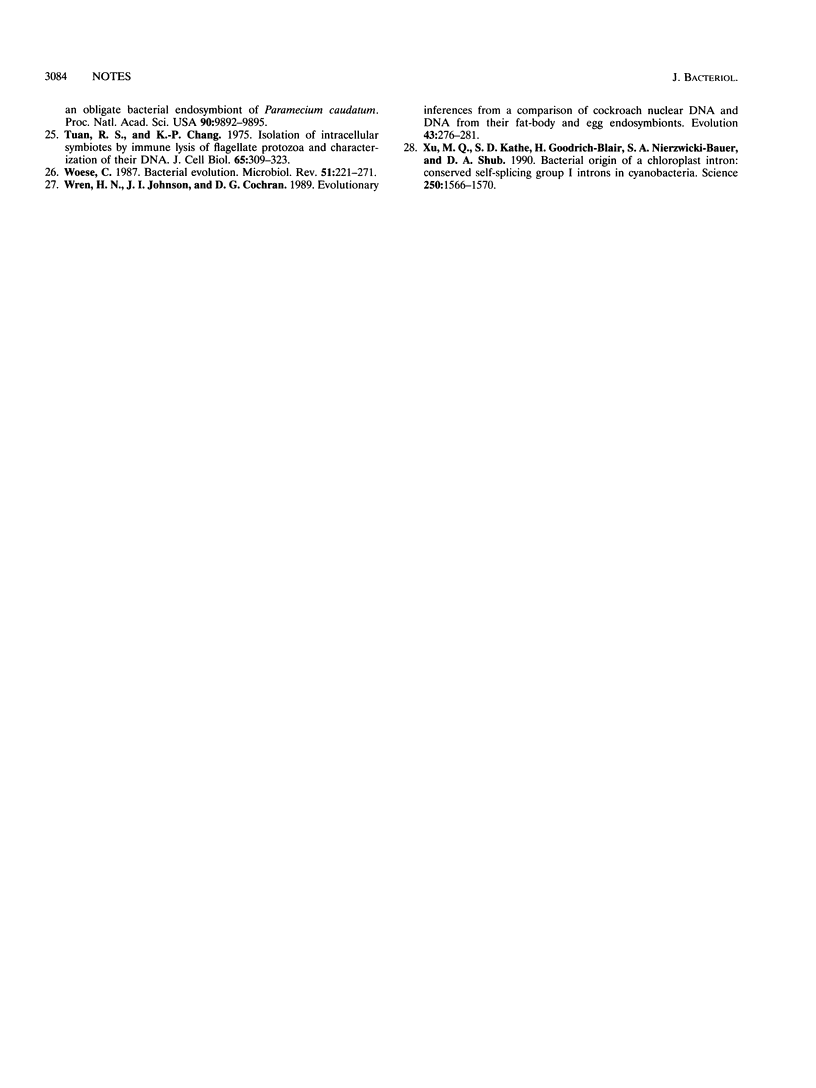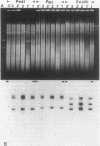Abstract
The 16S ribosomal DNA sequences of endosymbionts from the trypanosomatid protozoa (Crithidia spp.) are most homologous to that of Bordetella spp. This finding extends the polyphyletic origin of endosymbionts for the first time to the beta Proteobacteria. Biased base transitions and compensatory mutations of the symbionts' sequences that may contribute to their identity in the three Crithidia spp. are noted.
Full text
PDF



Images in this article
Selected References
These references are in PubMed. This may not be the complete list of references from this article.
- Chang K. P., Trager W. Nutritional significance of symbiotic bacteria in two species of hemoflagellates. Science. 1974 Feb 8;183(4124):531–532. doi: 10.1126/science.183.4124.531. [DOI] [PubMed] [Google Scholar]
- Chang K. P. Ultrastructure of symbiotic bacteria in normal and antibiotic-treated Blastocrithidia culicis and Crithidia oncopelti. J Protozool. 1974 Nov;21(5):699–707. doi: 10.1111/j.1550-7408.1974.tb03733.x. [DOI] [PubMed] [Google Scholar]
- Gray M. W., Doolittle W. F. Has the endosymbiont hypothesis been proven? Microbiol Rev. 1982 Mar;46(1):1–42. doi: 10.1128/mr.46.1.1-42.1982. [DOI] [PMC free article] [PubMed] [Google Scholar]
- Kimura M. Recent development of the neutral theory viewed from the Wrightian tradition of theoretical population genetics. Proc Natl Acad Sci U S A. 1991 Jul 15;88(14):5969–5973. doi: 10.1073/pnas.88.14.5969. [DOI] [PMC free article] [PubMed] [Google Scholar]
- McLaughlin G. L., Howe D. K., Biggs D. R., Smith A. R., Ludwinski P., Fox B. C., Tripathy D. N., Frasch C. E., Wenger J. D., Carey R. B. Amplification of rDNA loci to detect and type Neisseria meningitidis and other eubacteria. Mol Cell Probes. 1993 Feb;7(1):7–17. doi: 10.1006/mcpr.1993.1002. [DOI] [PubMed] [Google Scholar]
- Mundim M. H., Roitman I., Hermans M. A., Kitajima E. W. Simple nutrition of Crithidia deanei, a reduviid trypanosomatid with an endosymbiont. J Protozool. 1974 Oct;21(4):518–521. doi: 10.1111/j.1550-7408.1974.tb03691.x. [DOI] [PubMed] [Google Scholar]
- Munson M. A., Baumann P., Clark M. A., Baumann L., Moran N. A., Voegtlin D. J., Campbell B. C. Evidence for the establishment of aphid-eubacterium endosymbiosis in an ancestor of four aphid families. J Bacteriol. 1991 Oct;173(20):6321–6324. doi: 10.1128/jb.173.20.6321-6324.1991. [DOI] [PMC free article] [PubMed] [Google Scholar]
- Müller M., Hildebrandt A. Nucleotide sequences of the 23S rRNA genes from Bordetella pertussis, B.parapertussis, B.bronchiseptica and B.avium, and their implications for phylogenetic analysis. Nucleic Acids Res. 1993 Jul 11;21(14):3320–3320. doi: 10.1093/nar/21.14.3320. [DOI] [PMC free article] [PubMed] [Google Scholar]
- NEWTON B. A., HORNE R. W. Intracellular structures in Strigomonas oncopelti. I. Cytoplasmic structures containing ribonucleoprotein. Exp Cell Res. 1957 Dec;13(3):563–574. doi: 10.1016/0014-4827(57)90086-1. [DOI] [PubMed] [Google Scholar]
- Neefs J. M., Van de Peer Y., De Rijk P., Chapelle S., De Wachter R. Compilation of small ribosomal subunit RNA structures. Nucleic Acids Res. 1993 Jul 1;21(13):3025–3049. doi: 10.1093/nar/21.13.3025. [DOI] [PMC free article] [PubMed] [Google Scholar]
- Noller H. F. Structure of ribosomal RNA. Annu Rev Biochem. 1984;53:119–162. doi: 10.1146/annurev.bi.53.070184.001003. [DOI] [PubMed] [Google Scholar]
- O'Neill S. L., Gooding R. H., Aksoy S. Phylogenetically distant symbiotic microorganisms reside in Glossina midgut and ovary tissues. Med Vet Entomol. 1993 Oct;7(4):377–383. doi: 10.1111/j.1365-2915.1993.tb00709.x. [DOI] [PubMed] [Google Scholar]
- Ohtaka C., Ishikawa H. Accumulation of adenine and thymine in a groE-homologous operon of an intracellular symbiont. J Mol Evol. 1993 Feb;36(2):121–126. doi: 10.1007/BF00166247. [DOI] [PubMed] [Google Scholar]
- Olsen G. J., Overbeek R., Larsen N., Marsh T. L., McCaughey M. J., Maciukenas M. A., Kuan W. M., Macke T. J., Xing Y., Woese C. R. The Ribosomal Database Project. Nucleic Acids Res. 1992 May 11;20 (Suppl):2199–2200. doi: 10.1093/nar/20.suppl.2199. [DOI] [PMC free article] [PubMed] [Google Scholar]
- Rousset F., Pélandakis M., Solignac M. Evolution of compensatory substitutions through G.U intermediate state in Drosophila rRNA. Proc Natl Acad Sci U S A. 1991 Nov 15;88(22):10032–10036. doi: 10.1073/pnas.88.22.10032. [DOI] [PMC free article] [PubMed] [Google Scholar]
- Springer N., Ludwig W., Amann R., Schmidt H. J., Görtz H. D., Schleifer K. H. Occurrence of fragmented 16S rRNA in an obligate bacterial endosymbiont of Paramecium caudatum. Proc Natl Acad Sci U S A. 1993 Nov 1;90(21):9892–9895. doi: 10.1073/pnas.90.21.9892. [DOI] [PMC free article] [PubMed] [Google Scholar]
- Tuan R. S., Chang K. P. Isolation of intracellular symbiotes by immune lysis of flagellate protozoa and characterization of their DNA. J Cell Biol. 1975 May;65(2):309–323. doi: 10.1083/jcb.65.2.309. [DOI] [PMC free article] [PubMed] [Google Scholar]
- Woese C. R. Bacterial evolution. Microbiol Rev. 1987 Jun;51(2):221–271. doi: 10.1128/mr.51.2.221-271.1987. [DOI] [PMC free article] [PubMed] [Google Scholar]
- Xu M. Q., Kathe S. D., Goodrich-Blair H., Nierzwicki-Bauer S. A., Shub D. A. Bacterial origin of a chloroplast intron: conserved self-splicing group I introns in cyanobacteria. Science. 1990 Dec 14;250(4987):1566–1570. doi: 10.1126/science.2125747. [DOI] [PubMed] [Google Scholar]



